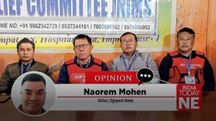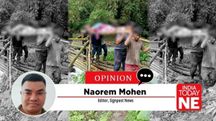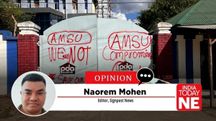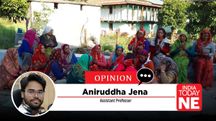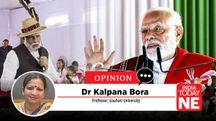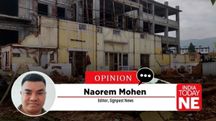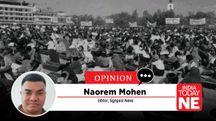Quest for Greater Mizoram Surges After Kuki's Separate Administration Dreams Crushed
On October 15, 2025, the Mizo Integration Council (MIC) was launched in Churachandpur town, led by R L Haokip, with a vision to unite Kuki, Zomi, Hmar, Paite, Vaiphei, and others—across Mizoram, Manipur, Assam, Tripura, and even parts of Myanmar and Bangladesh.
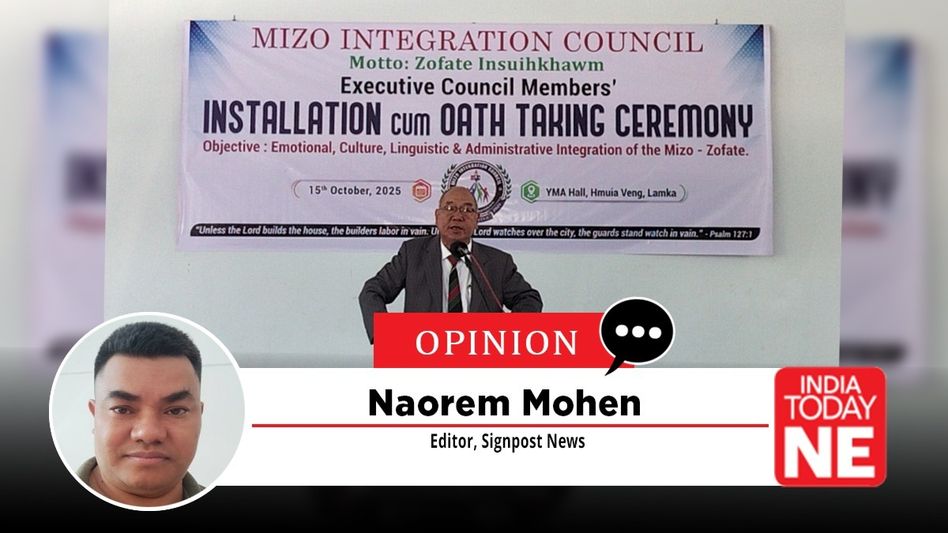
On October 15, 2025, the Mizo Integration Council (MIC) was launched in Churachandpur town led by R L Haokip, with a vision to unite Kuki, Zomi, Hmar, Paite, Vaiphei, and others—across Mizoram, Manipur, Assam, Tripura, and even parts of Myanmar and Bangladesh.
This followed the formation of the Mizo National Front–Integration Movement (MNF-IM) in September, which was swiftly disavowed by the Mizo National Front (MNF) in Aizawl.
When the central government, prioritizing Manipur’s territorial integrity, categorically rejected the Separate Administration demands, Kuki CSO pivoted to a new strategy: the revival of the "Greater Mizoram" vision.This vision, championed by groups like the Zomi Re-unification Organisation (ZRO), Kuki National Organisation (KNO), Kuki-Zo Council (KZC), Zomi Council (ZC), and Kuki Inpi Manipur (KIM), seeks to unite ethnic groups under a shared Mizo identity, either by integrating Mizo-inhabited areas with Mizoram or creating a new administrative entity.
The Kuki demand for a separate administration, envisioned as a Union Territory akin to Puducherry or Ladakh is not new. For years, Kuki leaders have argued that a separate administration, Or even a Kuki State is the only way to protect their cultural identity and secure equitable development, citing perceived Meitei dominance in state governance.
The MIC’s launch on October 15, marked by an Installation cum Oath-Taking Ceremony, raised Rs 38,500 from contributors like RL Haokip and LM Khaute (Rs 5,000 each), Franki, Thangpao Mate, Suakzathang Nunthuk, and Col. Sithlou (Rs 3,000 each), among others. This financial support reflects a committed base, but it also fuels a movement that risks destabilizing the region further.
This new organization has accepted that there are Kuki-Zo/Zomi/Zonathlak refugees and immigrants and their mission is for the survival and liberating themselves from Manipur. Citing Psalm 133:1—“How good and pleasant it is when brothers live together in unity!”—the MIC failed to remember "Thou shalt love thy neighbour as thyself.” —Matthew 22:39.
Both initiatives, draped in the rhetoric of cultural and administrative unity, emerged as a direct response to the Centre's rejection of the Kuki demand for a separate administration. Yet, strip away the lofty promises, and this so-called quest for Greater Mizoram reveals itself as a dangerous mirage—a divisive, ill-conceived campaign built on anti-Meitei sentiment, historical misreadings, and a reckless disregard for Manipur’s fragile ethnic mosaic.
In January 1965, delegates from diverse Non-Naga hill tribes and Mizo organizations convened at Kawnpui in Churachandpur to champion the unification of their scattered communities under a single administrative unit, emphasizing territorial integrity and shared descent to resolve longstanding fragmentation. They appealed to the Federal Government to shield their people from Naga-induced hardships, pledging neighborly coexistence while urgently seeking protection in vulnerable border areas like Tamenglong and Haflong against threats.
The 2025 Mizo Vision isn't mere rhetoric; it's a bold, if belated, pivot toward the long-dormant dream of Greater Mizoram, a transborder ethnic homeland that would swallow Kuki-Zo territories from Manipur into Mizoram and beyond. But why now? The answer lies in a toxic brew of desperation, opportunism, and raw power politics—one that risks reigniting the very infernos it claims to douse.
Yet, peel back the ethnic romance, and the MIC reeks of jobless CSO machinations—the kind of idle, unemployed activism that thrives on crisis but delivers little beyond headlines. Kuki CSOs, once laser-focused on a separate Union Territory (UT) with legislature, have watched their demands evaporate in bureaucratic fog.
With SoO-bound Kuki militants like the Kuki National Army growing restless—some factions even threatening free movement pacts with the Centre—these CSOs needed a fresh crusade. The MIC fills that void, rebranding separation as "integration" to court Mizoram's patronage while keeping the pot stirred. It's power politics at its most cynical: CSO leaders, bereft of electoral heft, leverage armed shadows to bargain from strength, holding highways hostage and peace processes ransom.
Political parties, scenting electoral windfalls, are all too eager accomplices. In Mizoram, such idea of a Greater Mizoram that could swell the voter base with Manipur's displaced Kukis—much like how the Mizo National Front once parlayed insurgency into statehood in 1986.
Mizoram's support is palpable: Chief Minister Lalduhoma, of the Zoram People's Movement (ZPM), has lambasted Manipur's N. Biren Singh as a "liability" for the BJP, while sheltering Kuki refugees and amplifying calls for their "organic brotherhood" with Mizos. In a region where Delhi's writ frays at the edges, such solidarity feels like salvation.
Their Greater Mizoram idea leans heavily on the 1986 Mizo Peace Accord, which Kuki leaders invoke as a blueprint for their ambitions. Signed on June 30, 1986, between Prime Minister Rajiv Gandhi’s government and the MNF under Laldenga, the accord ended a 20-year insurgency. The accord granted Mizoram statehood on February 20, 1987, with special protections under Article 371G, rehabilitated MNF cadres with jobs and land, and secured peace, transforming Mizoram into a model of stability. Laldenga became Chief Minister, and the MNF evolved into a mainstream political party.
Crucially, the accord never included provisions for a "Greater Mizoram" uniting Mizo-inhabited areas in Manipur, Assam, or Tripura. That demand, briefly raised during the insurgency, was quietly abandoned in favor of pragmatic statehood. Today’s leaders, by resurrecting this fulfilled pact, are chasing a fantasy that misreads history and ignores the accord’s core lesson: peace came through compromise within India’s federal framework, not through territorial expansion.
Undoubtedly, this Greater Mizoram vision rests on two precarious pillars: stoking anti-Meitei sentiment to unify fractured tribal loyalties and misinterpreting the Mizo Accord as a mandate for redrawing borders. The MIC and MNF-IM frame the Meitei community as an existential threat, accusing the Manipur government of being Meitei-centric and marginalizing hill tribes. This narrative paints Meiteis as monopolizing power, resources, and opportunities, while Kuki communities languish in neglected hill districts. By casting Meiteis as the primary obstacle, these groups aim to rally diverse Chin Kuki Hmar (CHIKIM) under a shared Mizo identity.
Yet, this strategy glosses over these tribes’ own internal divisions, which have historically fueled conflicts Kuki - Paite and Kuki - Hmar clashes. The second pillar—invoking the Mizo Accord—betrays a profound misreading of history. The accord was a tailored resolution to Mizoram’s insurgency, not a universal template for ethnic unification. Mizoram’s statehood was achieved through painstaking negotiations that respected India’s federal structure, not by demanding the annexation of neighboring territories. The MIC’s claim that the accord supports their cause is a deliberate distortion, akin to demanding a sequel to a story that already concluded.
Moreover, the MNF’s swift disavowal of MNF-IM exposes the disconnect. On September 17, the MNF, through a statement signed by B Lalhmangaihzualla, Secretary of MNF General Headquarters, declared no connection—formal or informal—with MNF-IM, emphasizing that no consultations had occurred regarding its territorial ambitions.
The MNF cautioned its members against participating in MNF-IM activities, signaling not just a rejection of the group’s methods but a broader disavowal of its vision. This rebuke highlights a critical flaw: without the political clout of Mizoram’s MNF, the Greater Mizoram dream lacks legitimacy and momentum.
Interestingly, in the Vision of Mizo Integration, PaTual T.Tualzathang preaching and the presidential address of RL Haokip is a masterclass in manipulative rhetoric, cloaking a divisive agenda in the garb of unity and divine providence. They claim that the Kuki, Chin, Mizo, and Zomi are “one family, created by God, bound by language, culture, and blood” is a convenient fiction that glosses over their distinct identities and histories. Wait, what happened to the Bnei Manashe, the lost tribe of Israel?
The appeal for cooperation with NGOs, global diaspora, civil society, and churches to “fight for survival and justice” is undermined by the MIC’s lack of a concrete plan. This isn’t a spiritual appeal; it’s a calculated move to sanctify a political project, using religion to mobilize the masses while sidestepping the complexities of ethnic diversity.
By invoking Article 3 of the Indian Constitution, which governs state reorganization, RL Haokip presents territorial integration as a legal possibility. Yet, this ignores the political realities: redrawing state boundaries requires consensus among states, communities, and the central government—a near-impossible feat in a region as fragmented as Northeast India, where even minor boundary disputes can spark violence.
Also Read: Why President's Rule in Manipur Fails the Churachandpur IDPs and the Relief Committee JNIMS
The rhetoric also flattens the distinct identities of Kuki, Zomi, and other Zo sub-groups into a monolithic “Mizo” narrative, risking erasure of their unique histories and struggles. The call for “Zofa Integration” may resonate emotionally, but it dismisses dissenters as traitors or collaborators, fostering resentment rather than reconciliation.
Declaring October 15 as “Mizo Integration and Unity Day” and appealing to the “global diaspora” and churches further amplifies this agenda, leveraging influential networks to push a cause that could deepen divisions in the region.The movement’s reliance on anti-Meitei fearmongering is particularly troubling. By exaggerating the specter of Meitei dominance—down to absurd claims about “Meitei” as a threat—the MIC and MNF-IM inflate a regional rivalry into a cosmic struggle. This tactic not only alienates Meiteis but also oversimplifies Manipur’s multi-ethnic reality, where Nagas, Kuki, Thadou, Meiteis, and others coexist with overlapping claims to land and power.
As expected, the 2023 violence, was a ethnic genocide, to demand a homeland, exacerbated by such divisive narratives, which pitted communities against each other in a zero-sum game. By doubling down on this approach, the MIC risks perpetuating a cycle of mistrust and conflict among the ethnic communities in the region.
The latest in the gamebit is a clear power game, hijacked by self-styled leaders who profit from perpetuating conflict while communities bear the cost. The MIC and MNF-IM are betting on a strategy history has repeatedly debunked. The hard truth is that territorial separatism in Northeast India rarely delivers lasting solutions, often deepening divisions and enriching a few leaders while communities suffer.
The activities of the Mizo Integration Council and the Mizo National Front–Integration Movement pose a significant challenge to stability in Manipur, and the authorities must take decisive action to curb their influence. These groups, driven by narrow-minded politics and fueled by certain civil society organization leaders with potential cross-border accomplices, threaten not only the Centre’s development plans but also India’s geopolitical standing in the region.
The Greater Mizoram quest, for all its fervor, is a house of cards built on shaky foundations. Its reliance on anti-Meitei rhetoric, historical misinterpretation, and spiritual manipulation threatens to deepen the state ethnic fault lines.
What begins as fraternal outreach could fracture into fresh feuds, especially if Myanmar's Chin State—another Greater Mizoram cog—tips into full civil war spillover.
Left unchecked, their actions could escalate into a broader security crisis, undermining India’s internal cohesion and regional influence. Swift and strategic intervention is essential to safeguard national interests and ensure long-term peace and progress in Manipur.
Copyright©2025 Living Media India Limited. For reprint rights: Syndications Today
